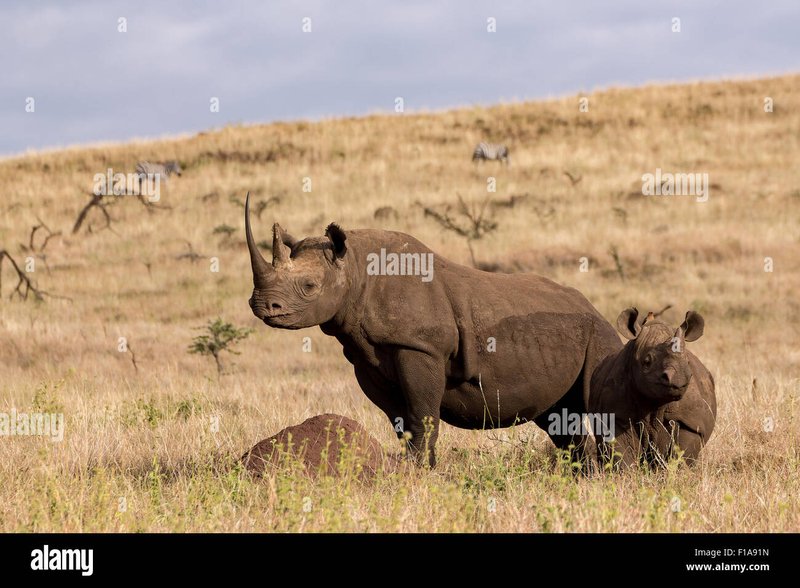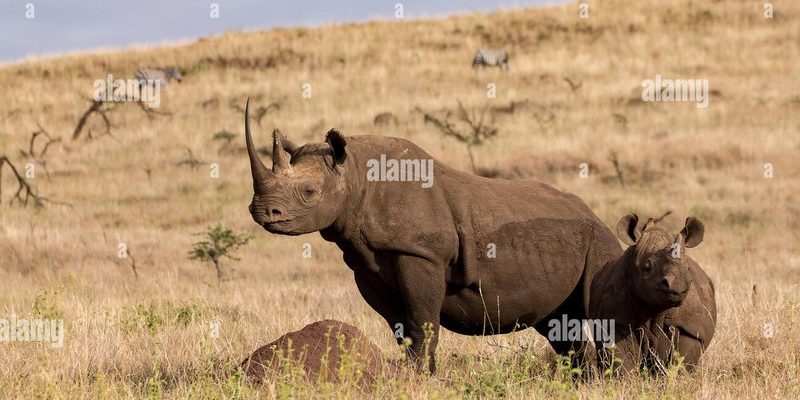
The Life of a Black Rhinoceros Calf
From the moment a black rhinoceros calf is born, its life is filled with both challenges and joys. Typically, calves are born after a gestation period of about 15-16 months, weighing around 50 to 70 pounds. They come into the world with a few survival skills instinctively kicking in. Yet, they’re totally reliant on their mothers for food, protection, and learning how to navigate their environment.
Motherhood in the Wild is no easy task. A female black rhinoceros will usually raise one calf at a time and can be quite protective. A mother will keep her calf close for safety, often making the young calf follow her closely as they roam their territory in search of food. You might compare this to a parent holding a child’s hand while crossing a busy street—it’s all about ensuring safety and teaching independence simultaneously.
Bonding Through Play
Playtime is incredibly important for black rhinoceros calves. Just like human children, these young rhinos engage in playful activities that help them learn vital skills. They practice their physical abilities, like running and charging, which are essential for their survival as they grow older.
During these playful moments, you might see calves sparring with each other using their heads and horns. This isn’t just fun; it helps them develop strength and coordination. Think of it as a rhino version of a playground! These interactions are key to fostering social skills and learning about their place in the herd.
Maternal Guidance
A black rhinoceros mother plays an essential role in teaching her calf how to survive in the wild. She’ll guide her young one towards food sources and safe watering holes, which are critical for nutrition and hydration. The calf learns to recognize different plants and their nutritional value thanks to its mother’s direction.
Here’s the thing: a mother rhino will also teach her calf about potential dangers in their environment. For instance, if there are predators nearby, the mother will display warning behaviors, helping the calf understand when to be cautious. It’s much like a parent pointing out hotspots for danger while teaching a child to be aware of their surroundings.
Protecting the Young
Protection is a top priority for black rhinoceros mothers. They are known to be fiercely protective of their young, willing to fight off threats, whether it’s a lion or an intruding rhino. The mother will often use her size and strength to intimidate potential dangers, creating a bubble of safety around her calf.
Hiding Spots are also a smart strategy these mothers use. When they sense danger, a mother might lead her calf to dense bushes or thickets where they can hide. This is similar to how a parent might hide their child during a scary situation, shielding them until it’s safe to come out again.
Weaning and Independence
Typically, black rhinoceros calves will nurse for about 2-3 years before they start weaning off their mother’s milk. This process is gradual; the calf will often start munching on solid food while still nursing. By about three years old, the young rhino is mostly independent, but it usually stays with its mother for several more months or even years.
During this period, the calf learns to be self-sufficient while still enjoying the comfort of having its mother nearby. It’s kind of like how teens start venturing out on their own. They want freedom, but having a parental figure is still crucial for guidance and reassurance.
The Importance of Social Learning
Beyond just their mothers, young black rhinoceroses learn a lot from observing other rhinos in the herd. This social learning is vital for their development. They watch older rhinos to see how they interact, feed, and deal with other species in the ecosystem.
This communal aspect of learning is fascinating. For example, if a calf sees an older rhino using its horn to dig for minerals in the ground, it may try to mimic that behavior. This kind of observation helps rhinos adapt and grow, which is crucial for their long-term survival.
The Role of the Environment
The habitat of black rhinoceroses plays a significant role in how they raise their young. These animals primarily inhabit savannas, grasslands, and forests, which provide a rich source of food and shelter. Healthy ecosystems allow mothers to access the resources they need to nurture their calves.
In areas where their habitat is threatened or fragmented, raising young becomes more difficult. Less access to food and water affects the calf’s growth and the mother’s ability to care for it. That’s why conservation efforts are so important—not just to protect the rhinos but to ensure that future generations can thrive in their natural environments.
Raising young black rhinoceroses in the wild is a beautiful yet challenging responsibility. From the early stages of nurturing to teaching valuable survival skills, these mothers play a crucial role in shaping the next generation of rhinos. Observing their behaviors—like bonding through play and protecting their calves—gives us insight into their dedicated parenting styles.
As these magnificent creatures face threats from habitat loss and poaching, understanding their nurturing ways can help us appreciate the challenges they encounter. By working to protect their wild habitats, we can give black rhinoceroses and their young the chance to thrive for generations to come. Every step we take towards conservation counts, helping ensure that future calves will roam the savanna just like their mothers did before them.

